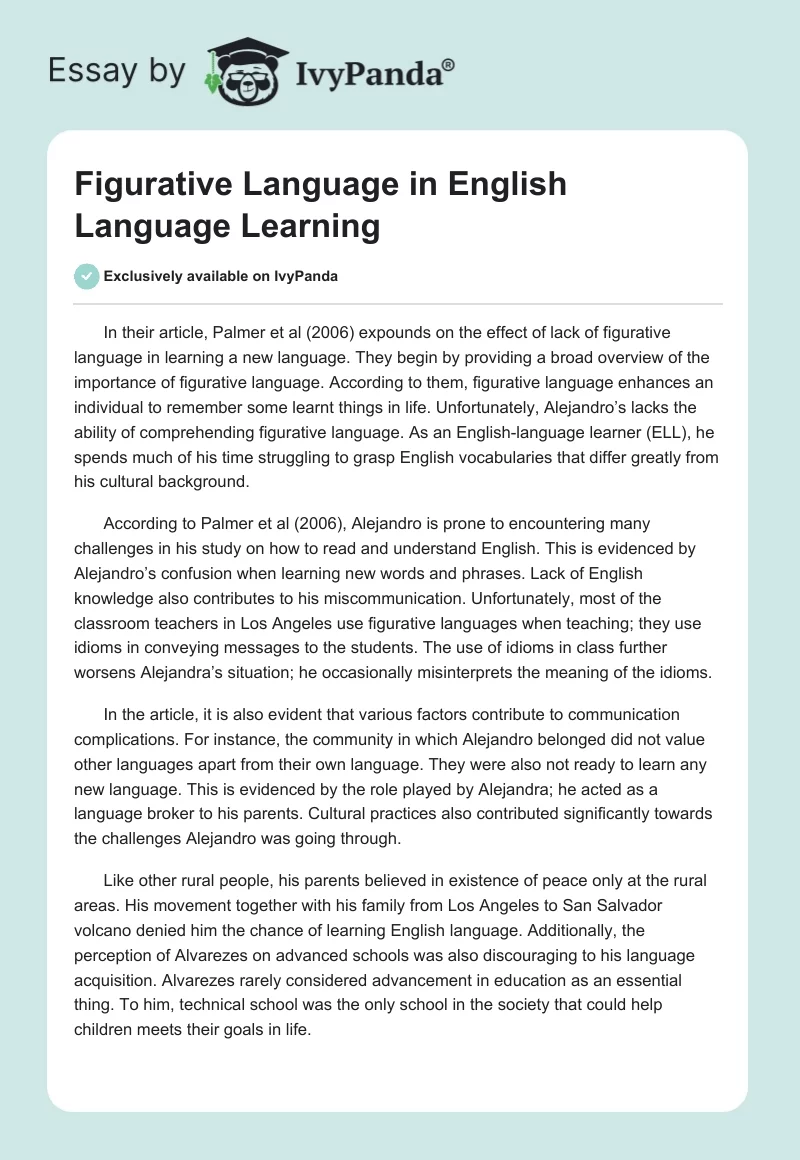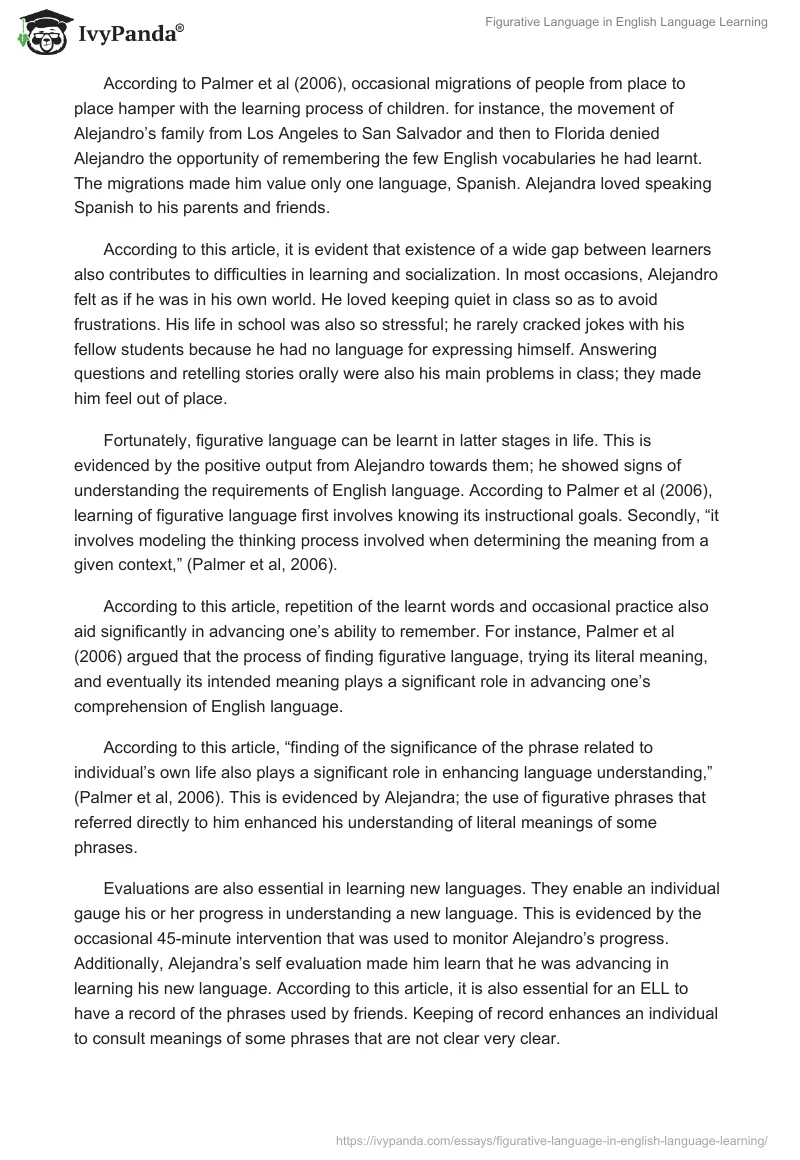In their article, Palmer et al (2006) expounds on the effect of lack of figurative language in learning a new language. They begin by providing a broad overview of the importance of figurative language. According to them, figurative language enhances an individual to remember some learnt things in life. Unfortunately, Alejandro’s lacks the ability of comprehending figurative language. As an English-language learner (ELL), he spends much of his time struggling to grasp English vocabularies that differ greatly from his cultural background.
According to Palmer et al (2006), Alejandro is prone to encountering many challenges in his study on how to read and understand English. This is evidenced by Alejandro’s confusion when learning new words and phrases. Lack of English knowledge also contributes to his miscommunication. Unfortunately, most of the classroom teachers in Los Angeles use figurative languages when teaching; they use idioms in conveying messages to the students. The use of idioms in class further worsens Alejandra’s situation; he occasionally misinterprets the meaning of the idioms.
In the article, it is also evident that various factors contribute to communication complications. For instance, the community in which Alejandro belonged did not value other languages apart from their own language. They were also not ready to learn any new language. This is evidenced by the role played by Alejandra; he acted as a language broker to his parents. Cultural practices also contributed significantly towards the challenges Alejandro was going through.
Like other rural people, his parents believed in existence of peace only at the rural areas. His movement together with his family from Los Angeles to San Salvador volcano denied him the chance of learning English language. Additionally, the perception of Alvarezes on advanced schools was also discouraging to his language acquisition. Alvarezes rarely considered advancement in education as an essential thing. To him, technical school was the only school in the society that could help children meets their goals in life.
According to Palmer et al (2006), occasional migrations of people from place to place hamper with the learning process of children. for instance, the movement of Alejandro’s family from Los Angeles to San Salvador and then to Florida denied Alejandro the opportunity of remembering the few English vocabularies he had learnt. The migrations made him value only one language, Spanish. Alejandra loved speaking Spanish to his parents and friends.
According to this article, it is evident that existence of a wide gap between learners also contributes to difficulties in learning and socialization. In most occasions, Alejandro felt as if he was in his own world. He loved keeping quiet in class so as to avoid frustrations. His life in school was also so stressful; he rarely cracked jokes with his fellow students because he had no language for expressing himself. Answering questions and retelling stories orally were also his main problems in class; they made him feel out of place.
Fortunately, figurative language can be learnt in latter stages in life. This is evidenced by the positive output from Alejandro towards them; he showed signs of understanding the requirements of English language. According to Palmer et al (2006), learning of figurative language first involves knowing its instructional goals. Secondly, “it involves modeling the thinking process involved when determining the meaning from a given context,” (Palmer et al, 2006).
According to this article, repetition of the learnt words and occasional practice also aid significantly in advancing one’s ability to remember. For instance, Palmer et al (2006) argued that the process of finding figurative language, trying its literal meaning, and eventually its intended meaning plays a significant role in advancing one’s comprehension of English language.
According to this article, “finding of the significance of the phrase related to individual’s own life also plays a significant role in enhancing language understanding,” (Palmer et al, 2006). This is evidenced by Alejandra; the use of figurative phrases that referred directly to him enhanced his understanding of literal meanings of some phrases.
Evaluations are also essential in learning new languages. They enable an individual gauge his or her progress in understanding a new language. This is evidenced by the occasional 45-minute intervention that was used to monitor Alejandro’s progress. Additionally, Alejandra’s self evaluation made him learn that he was advancing in learning his new language. According to this article, it is also essential for an ELL to have a record of the phrases used by friends. Keeping of record enhances an individual to consult meanings of some phrases that are not clear very clear.
In conclusion, figurative language is so essential to a person learning a new language. It enables an individual an individual remember learnt things about the new language. Lack of understanding figurative language hampers with the learning process of a new language; it makes an individual spend more time on the learning process.
Many factors contribute to occurrence of complications in communication, and among them include cultural practice, migrations from place to place, and existence of wide gaps between learners. However, figurative language can be learnt in latter stages in life via knowing its instructional goals, determining the meaning from a given context, and practicing occasionally.
Reference
Palmer, B. (2006). Bridging two worlds: Reading comprehension, figurative language instruction, and the English-language. Journal of International Reading Association, 50(4), 258–267.


